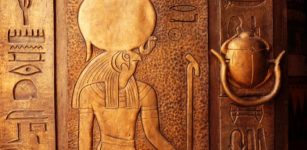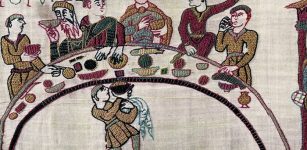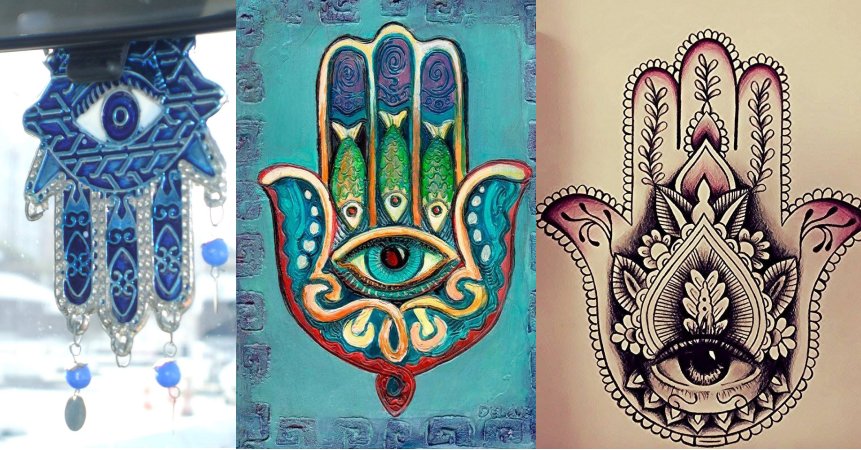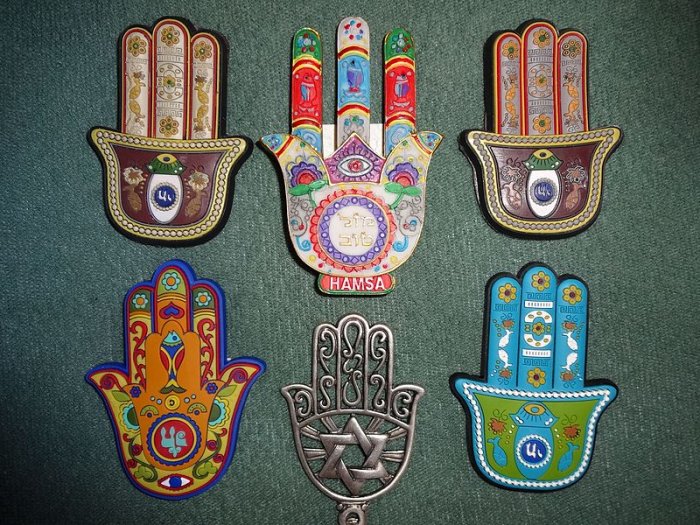Ancient Symbol Hamsa: It’s Meaning And History Explained
Ellen Lloyd - AncientPages.com - Hamsa is an ancient, powerful symbol that is often carried as an amulet to invoke the hand of God, or to counteract the Evil Eye. Tracing the roots of this ancient symbol is not easy because Jewish, Christian, and Muslim scholars cannot agree on the interpretation of Hamsa.
Depicted as an eye embedded in the palm of an open hand, the Hamsa symbol has had numerous other names throughout the ages. Some scholars think the symbol is of Pagan origin and was later adopted by other religions. It’s possible the Hamsa symbol originates from Mesopotamia, ancient Egypt, or Cartage, where a Punic and Phoenician goddess Tanit was worshipped.
Hamsa Symbol Protects From Harm Caused By The Evil Eye
Hamsa is a universal protective sign and we encounter it in faiths. It is believed the symbol brings its owner happiness, luck, health, and good fortune. Hamsa offers protection from harm caused by the evil eye. As previously mentioned in Ancient Pages, there is an ancient, superstitious, and almost universal belief that certain people possess the supernatural power to cause disaster, illness, calamity and even death.
They have the ability to do it with a gaze or stare that gives an unpleasant emotion. The evil eye is widely feared in many parts of the world.
This is why the Hamsa symbol can be found today throughout the Middle East. Wearing charms or amulets is technically against Qu’ran law, but in Islamic countries, one can often see plaques or other items that depict the Hamsa symbol. There are Hamsa bracelets, necklaces, pendants, door-knocker, and many other objects depicting the powerful symbol.
By wearing it or keeping it at home, people believe they can protect themselves from negative influences that are otherwise outside their control. The hand can be depicted with the fingers spread apart to ward off evil, or as closed together to bring good luck.
Hamsa Symbol Used By Jews, Muslims And Christians
The Hamsa symbol is especially popular among Jews and Muslims. The Hamsa is variously known as the Hand of Fatima (Mohammed’s daughter) and the Hand of Merriam (Moses’ sister) suggests, which is why the amulet carries significance to both Jews and Muslims. It is also sometimes referred to as the Hand of Mary representing Mary, mother of Jesus.
The word, "Hamsa," derives its name from the five fingers on the hand. The earliest use of a Hamsa predates Islam, although the name Hamsa is Arabic. It is one of the national symbols of Algeria and appears in its emblem.
According to one theory, ancient Egyptians carried an amulet with two fingers that represented Isis and Osiris and the thumb, their child Horus. The amulet was used to invoke the protective spirits of parents over their child.
Other researchers suggest that between 1550 – 330 B.C., the Phoenicians used an image of the hand to represent Tanit, patron goddess of their capital city Carthage and controller of the lunar cycle. Some have suggested Tanit may have been one of the Greek goddesses such as Hera and Athena.
Examples of Hamsa - Credit: Wikipedia
In Hebrew, the number five is "hamesh" and "Hamesh" is representative of the five books of the Torah. It also symbolizes the fifth letter of the Hebrew alphabet, "Het", which represents one of God's holy names, and further reminds Jews to use their five senses when praising God. Some Sunnis interpret the five fingers of the Hamsa as representing the Five Pillars of Islam.
Today, many Jews and Arabs wear the Hamsa to demonstrate the common ground shared by them and the common source from which their religions spring. In the modern world, Hamsa has become a symbol of hope and peace.
Written by - Ellen Lloyd – AncientPages.com
Copyright © AncientPages.com All rights reserved. This material may not be published, broadcast, rewritten or redistributed in whole or part without the express written permission of AncientPages.com
Expand for referencesMore From Ancient Pages
-
 Evidence Europeans Used Slash-And-Burn Methods 9,500 Years Ago For Agriculture Purposes
Archaeology | May 18, 2022
Evidence Europeans Used Slash-And-Burn Methods 9,500 Years Ago For Agriculture Purposes
Archaeology | May 18, 2022 -
 Codebreakers Crack Secrets Of The Lost Letters Of Mary, Queen Of Scots
News | Feb 8, 2023
Codebreakers Crack Secrets Of The Lost Letters Of Mary, Queen Of Scots
News | Feb 8, 2023 -
 On This Day In History: Coverdale Bible Printed In English For The First Time – On Oct 4, 1535
News | Oct 4, 2016
On This Day In History: Coverdale Bible Printed In English For The First Time – On Oct 4, 1535
News | Oct 4, 2016 -
 LIDAR Discovers Circular Iron Age Village At Cap d’Erquy, France
Archaeology | Apr 4, 2024
LIDAR Discovers Circular Iron Age Village At Cap d’Erquy, France
Archaeology | Apr 4, 2024 -
 Are We Really In A Sixth Mass Extinction?
News | Apr 11, 2023
Are We Really In A Sixth Mass Extinction?
News | Apr 11, 2023 -
 Freemasons Secrets – American Democracy Is Part Of An Ancient Universal Plan – Secret Societies’ Role – Part 3
Ancient Mysteries | Jul 14, 2018
Freemasons Secrets – American Democracy Is Part Of An Ancient Universal Plan – Secret Societies’ Role – Part 3
Ancient Mysteries | Jul 14, 2018 -
 On This Day In History: King James I Of Scotland Was Assassinated – On Feb 21, 1437
News | Feb 21, 2017
On This Day In History: King James I Of Scotland Was Assassinated – On Feb 21, 1437
News | Feb 21, 2017 -
 Ancient Tomb With A Massive False Door Belonging To Prince Waser-If-Re Unearthed In Saqqara, Egypt
Archaeology | May 12, 2025
Ancient Tomb With A Massive False Door Belonging To Prince Waser-If-Re Unearthed In Saqqara, Egypt
Archaeology | May 12, 2025 -
 Lake Huron Was Home To A 9,000-Year-Old Civilization – Underwater Structures And Artifacts Reveal
Archaeology | Jun 17, 2021
Lake Huron Was Home To A 9,000-Year-Old Civilization – Underwater Structures And Artifacts Reveal
Archaeology | Jun 17, 2021 -
 Sun God Ra Was Venerated In Every Age Of Ancient Egypt’s Long Dynastic History
Egyptian Mythology | May 3, 2021
Sun God Ra Was Venerated In Every Age Of Ancient Egypt’s Long Dynastic History
Egyptian Mythology | May 3, 2021 -
 Battle Of Cape Ecnomus: One Of The Greatest Naval Battles In History
Ancient History Facts | Jun 17, 2019
Battle Of Cape Ecnomus: One Of The Greatest Naval Battles In History
Ancient History Facts | Jun 17, 2019 -
 On This Day In History: David I Becomes King Of Scots – On Apr 27, 1124
News | Apr 27, 2016
On This Day In History: David I Becomes King Of Scots – On Apr 27, 1124
News | Apr 27, 2016 -
 Jason And The Argonauts – Hate, Sorcery, Love And Jealousy Reign In This Famous Greek Story
Featured Stories | Jan 6, 2022
Jason And The Argonauts – Hate, Sorcery, Love And Jealousy Reign In This Famous Greek Story
Featured Stories | Jan 6, 2022 -
 Is There An Over-Looked Ancient Secret In Sahara?- Intriguing Theory Examined
Ancient Mysteries | Jul 30, 2019
Is There An Over-Looked Ancient Secret In Sahara?- Intriguing Theory Examined
Ancient Mysteries | Jul 30, 2019 -
 Peculiar Neolithic Anomaly Investigated In Scotland
Featured Stories | Apr 27, 2024
Peculiar Neolithic Anomaly Investigated In Scotland
Featured Stories | Apr 27, 2024 -
 Ancient Secrets Of Rare Maps Of Judah Ben Zara Revealed
Artifacts | Sep 20, 2022
Ancient Secrets Of Rare Maps Of Judah Ben Zara Revealed
Artifacts | Sep 20, 2022 -
 Sound Healing And Crystal Therapy, Ancient Arts Being Practiced Today – What Does Science Say?
Featured Stories | Mar 25, 2017
Sound Healing And Crystal Therapy, Ancient Arts Being Practiced Today – What Does Science Say?
Featured Stories | Mar 25, 2017 -
 Supernatural Beliefs Of Medieval People – From Elves And Fairies To Abductions And The Undead
Featured Stories | Nov 1, 2024
Supernatural Beliefs Of Medieval People – From Elves And Fairies To Abductions And The Undead
Featured Stories | Nov 1, 2024 -
 Early Twelfth-Century Castle Walls Unearthed Outside Gloucester, England
Archaeology | Dec 9, 2015
Early Twelfth-Century Castle Walls Unearthed Outside Gloucester, England
Archaeology | Dec 9, 2015 -
 Bayeux Tapestry: Original Location Of Remarkable Romanesque Art – Finally Solved
Archaeology | Oct 26, 2019
Bayeux Tapestry: Original Location Of Remarkable Romanesque Art – Finally Solved
Archaeology | Oct 26, 2019


